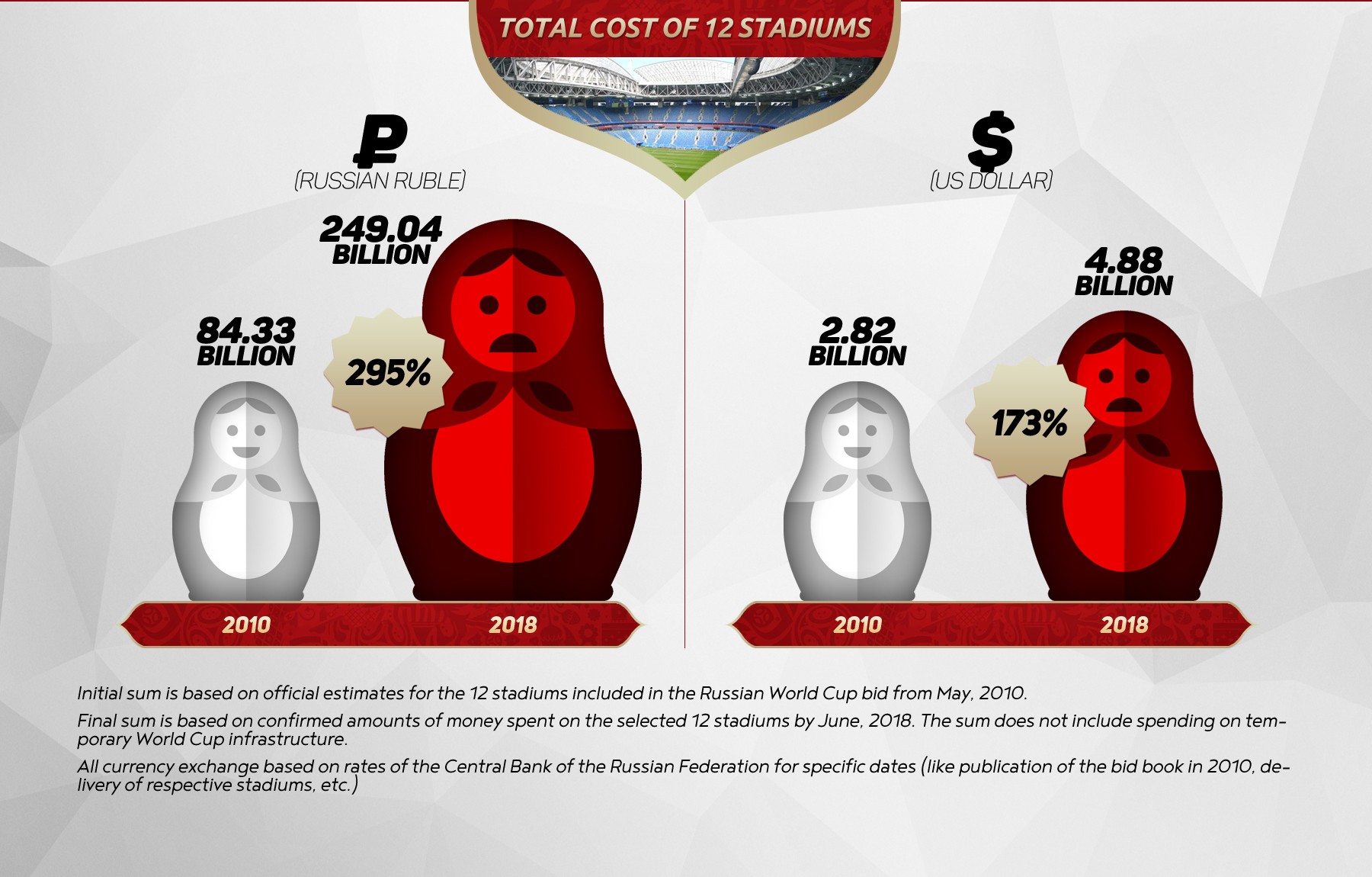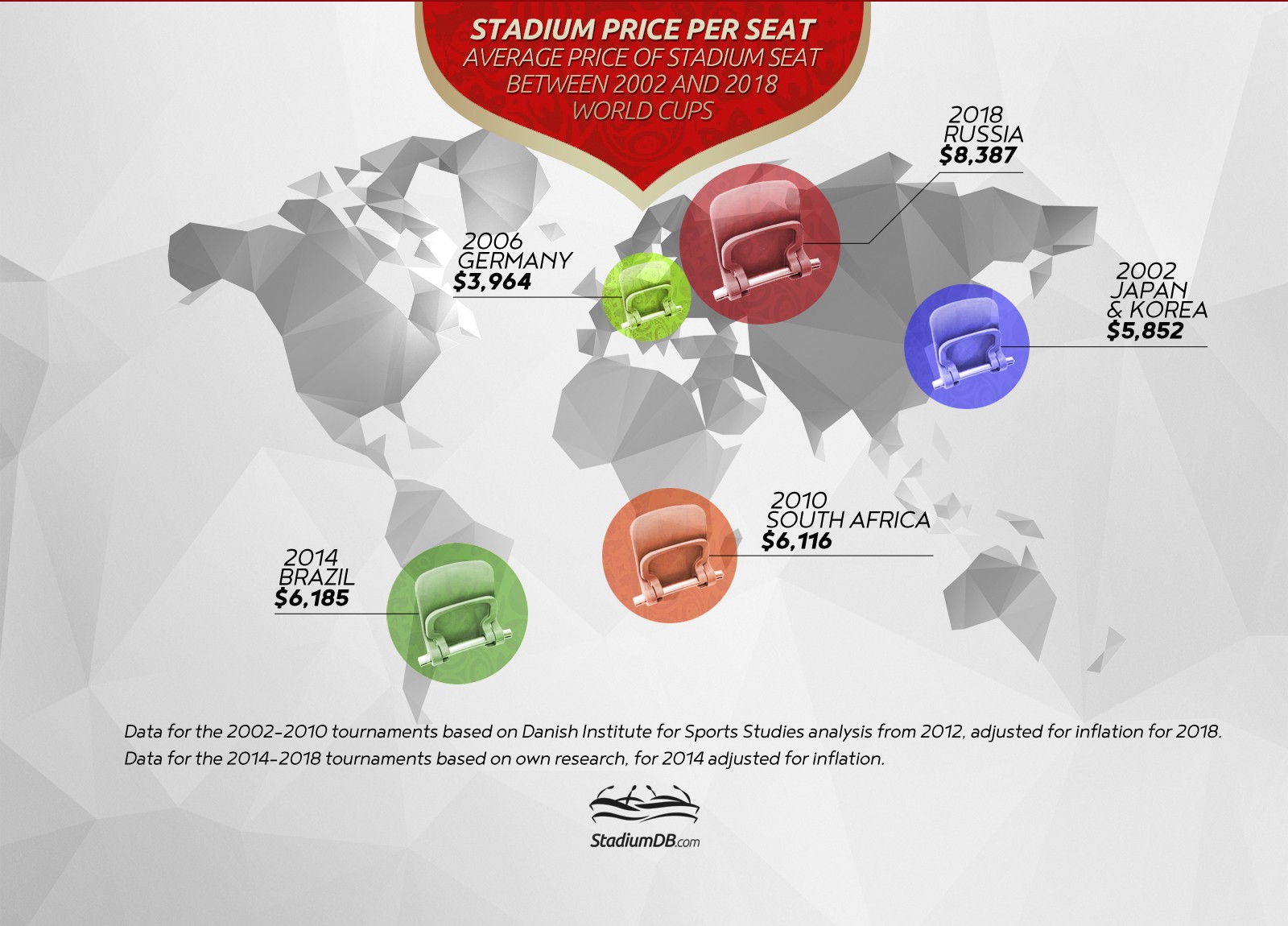Report: Why is Russia's World Cup so expensive? (Part 1)
source: StadiumDB.com; author: michał
 When their bid was evaluated by FIFA, Russia pledged to build the 12 host stadiums for $2.8 billion. They ended up with almost $5 billion spent and only because their currency collapsed, causing favourable exchange rates. In rubles the price has actually tripled!
When their bid was evaluated by FIFA, Russia pledged to build the 12 host stadiums for $2.8 billion. They ended up with almost $5 billion spent and only because their currency collapsed, causing favourable exchange rates. In rubles the price has actually tripled!
Advertisement
We've spent quite some time on this analysis, because we hope to present the most important data in a simple and clear way, while at the same not leaving out the complex circumstances. Seems doomed from the start, which is where we have to add that as of now we do not know, how much money was and will be spent on the World Cup stadiums. But then again, neither do the Russians as we see reports of additional works being planned in Samara, Yekaterinburg or Saint Petersburg, etc.
What has to be clear is that no other World Cup saw so much money being spent on stadium infrastructure. In total Russia has spent some $4.88 billion so far to deliver the 12 host venues, of which only one was built as a private project (Spartak stadium, built with Lukoil funds).

The total stadium budget is thus a whole $1 billion greater than in Brazil before their 2014 World Cup. And even the nearly $5-billion price tag is kept so low due to the 2014-2017 collapse of Russia's ruble. It's worth mentioning that the last pre-collapse estimate suggested stadiums would have cost a whopping $6.9 billion.
In US dollars the price may thus seem only somewhat impressive, having avoided the negative scenario. But in rubles the tournament's stadiums have so far cost nearly 3 times as much as they were supposed to back in 2010, when Russia estimated its spending on infrastructure to win FIFA's selection. Instead of roughly RUB 84 billion, almost 250 billion has been spent already.
Candidacy was far too optimistic
We decided to follow the route each of the 12 projects took from the times of Russian bid book submitted to FIFA. One observation comes to mind instantly: price estimates for many stadiums were overly optimistic, if not to the point of negligence, yet still accepted by FIFA.
It can be seen clearly with the example of stadiums already being close to construction or under construction when Russia filed the 2010 bid. Kazan Arena, Otkritie Arena and Stadion Fisht were all given price estimates of $255 million on average. They were deemed 25% more expensive than stadia in Kaliningrad, Volgograd, Saransk, Rostov or Samara (on average each expected to be worth $200m). This comes as unexplained especially that each of these stadiums was to have capacity no smaller than the trio from Kazan/Sochi/Moscow and was planned for construction in wetland areas, which increases cost significantly.
Similar underestimate seems obvious with regard to Luzhniki. The national stadium at that point was expected to have over 10,000 more seats than it holds during this year's tournament and yet was expected to cost only $240 million. Similar optimism regarding Yekaterinburg ($160m) also seems surprising.
Turbulent execution period
We have to stress once more that there are objective factors impacting the construction process and chief among them is the ruble collapse of 2014-2017. While the above mentioned stadia in Sochi, Moscow and Kazan were built just before the crash of mid-2014, with stable currency, the ruble lost almost half of its value in the crucial period when many other stadiums were just getting off the ground. And, as with all international-standard stadia, a lot of their technology and equipment was to come from abroad, from screens, through cable roofs to software.
Hasty interventions into the designs were focused on limiting imports and basing the infrastructure on domestic products. Some designs were simplified significantly, others thrown out entirely, with Kaliningrad serving as prime example. Kaliningrad is also one of the stadia most marred with corruption allegations, however we have no proof that cost in this western city – or any other – were inflated illegally. More detailed look into each of the 12 stadiums will be published as part two of this report.
Compared to the rest of the world
Already in 2010 it was expected to be among the most expensive World Cups in history, probably number one. In 2014 that became blatantly clear, when an evaluation in Russian Analytical Digest suggested stadium price per seat of stunning $11,600.
Just after that report was published the currency lost its value and the final outcome doesn't look as bad for Russia. Still, despite our rather favourable estimate we came up with $8,387 per seat, over $2,000 more for every seat than in Brazil and South Africa.

Advertisement
 StadiumDB
StadiumDB